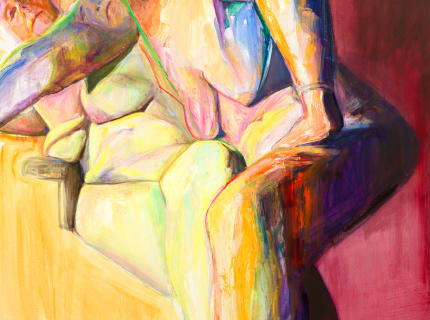SUBIN ANDERSON: Your paintings seem to explore different layers of seeing—from direct observation to reflections in mirrors, through cameras, and the translation of a photograph onto canvas. I wonder if these shifts in the process also shift the act of looking for you, revealing something different, not just in painting but in your perception over time.
JOAN SEMMEL: I don’t think of it so much in terms of observation. For me, making art is much more conceptual—first comes an idea, then a search for it, and finally, the production of the work. It’s less about asking, “How do I see this?” and more about, “How do I think about it?”
So, what do I think about the nude? Why do I think about the nude? Why use my own body? Why am I doing this at all? Those questions come first, even before I look at my body or whatever else I’m painting.
My initial impulse to move from abstraction back to the figure came from my political involvement as a feminist in the early ’70s. I wanted to examine why the female nude is so prevalent throughout art history—what kind of image it represents and how it affects the way a woman perceives herself. That was the driving force behind my painting, rather than simply observing what was in front of me.
So, when I began working with the female nude, I wanted it to be unmistakable that this image was made by a woman—not by a woman seen through a man’s eyes. What were the differences in that perspective? That’s how I started working with figuration, and it was important to me that the nude itself embodied this viewpoint.
SA: Since you described your approach as conceptual—driven by questions rather than direct observation—could you talk more about that process? And how does it translate into working in series?
JS: It’s really about staying engaged and not getting bored, right? I mean, how many ways can I look at myself? How many angles can I explore? I need to keep things fresh.
But also, figuration for me was never a cause—it wasn’t the end goal. I was an abstract painter at heart, and I think abstractly and conceptually. So, it wasn’t about what I was seeing; it was about what the work was saying to me.
A big part of painting is simply that I love working with paint—creating an image on a canvas, manipulating it, and letting it speak back to me. And of course, I always like to feel the work presents new challenges.
...
Read full interview at plusmagazines.net

